Xiaoming Zhai
AutoSCORE: Enhancing Automated Scoring with Multi-Agent Large Language Models via Structured Component Recognition
Sep 26, 2025


Abstract:Automated scoring plays a crucial role in education by reducing the reliance on human raters, offering scalable and immediate evaluation of student work. While large language models (LLMs) have shown strong potential in this task, their use as end-to-end raters faces challenges such as low accuracy, prompt sensitivity, limited interpretability, and rubric misalignment. These issues hinder the implementation of LLM-based automated scoring in assessment practice. To address the limitations, we propose AutoSCORE, a multi-agent LLM framework enhancing automated scoring via rubric-aligned Structured COmponent REcognition. With two agents, AutoSCORE first extracts rubric-relevant components from student responses and encodes them into a structured representation (i.e., Scoring Rubric Component Extraction Agent), which is then used to assign final scores (i.e., Scoring Agent). This design ensures that model reasoning follows a human-like grading process, enhancing interpretability and robustness. We evaluate AutoSCORE on four benchmark datasets from the ASAP benchmark, using both proprietary and open-source LLMs (GPT-4o, LLaMA-3.1-8B, and LLaMA-3.1-70B). Across diverse tasks and rubrics, AutoSCORE consistently improves scoring accuracy, human-machine agreement (QWK, correlations), and error metrics (MAE, RMSE) compared to single-agent baselines, with particularly strong benefits on complex, multi-dimensional rubrics, and especially large relative gains on smaller LLMs. These results demonstrate that structured component recognition combined with multi-agent design offers a scalable, reliable, and interpretable solution for automated scoring.
Rethinking the Potential of Layer Freezing for Efficient DNN Training
Aug 20, 2025Abstract:With the growing size of deep neural networks and datasets, the computational costs of training have significantly increased. The layer-freezing technique has recently attracted great attention as a promising method to effectively reduce the cost of network training. However, in traditional layer-freezing methods, frozen layers are still required for forward propagation to generate feature maps for unfrozen layers, limiting the reduction of computation costs. To overcome this, prior works proposed a hypothetical solution, which caches feature maps from frozen layers as a new dataset, allowing later layers to train directly on stored feature maps. While this approach appears to be straightforward, it presents several major challenges that are severely overlooked by prior literature, such as how to effectively apply augmentations to feature maps and the substantial storage overhead introduced. If these overlooked challenges are not addressed, the performance of the caching method will be severely impacted and even make it infeasible. This paper is the first to comprehensively explore these challenges and provides a systematic solution. To improve training accuracy, we propose \textit{similarity-aware channel augmentation}, which caches channels with high augmentation sensitivity with a minimum additional storage cost. To mitigate storage overhead, we incorporate lossy data compression into layer freezing and design a \textit{progressive compression} strategy, which increases compression rates as more layers are frozen, effectively reducing storage costs. Finally, our solution achieves significant reductions in training cost while maintaining model accuracy, with a minor time overhead. Additionally, we conduct a comprehensive evaluation of freezing and compression strategies, providing insights into optimizing their application for efficient DNN training.
Using Large Language Models to Assess Teachers' Pedagogical Content Knowledge
May 25, 2025Abstract:Assessing teachers' pedagogical content knowledge (PCK) through performance-based tasks is both time and effort-consuming. While large language models (LLMs) offer new opportunities for efficient automatic scoring, little is known about whether LLMs introduce construct-irrelevant variance (CIV) in ways similar to or different from traditional machine learning (ML) and human raters. This study examines three sources of CIV -- scenario variability, rater severity, and rater sensitivity to scenario -- in the context of video-based constructed-response tasks targeting two PCK sub-constructs: analyzing student thinking and evaluating teacher responsiveness. Using generalized linear mixed models (GLMMs), we compared variance components and rater-level scoring patterns across three scoring sources: human raters, supervised ML, and LLM. Results indicate that scenario-level variance was minimal across tasks, while rater-related factors contributed substantially to CIV, especially in the more interpretive Task II. The ML model was the most severe and least sensitive rater, whereas the LLM was the most lenient. These findings suggest that the LLM contributes to scoring efficiency while also introducing CIV as human raters do, yet with varying levels of contribution compared to supervised ML. Implications for rater training, automated scoring design, and future research on model interpretability are discussed.
Artificial Intelligence Bias on English Language Learners in Automatic Scoring
May 15, 2025Abstract:This study investigated potential scoring biases and disparities toward English Language Learners (ELLs) when using automatic scoring systems for middle school students' written responses to science assessments. We specifically focus on examining how unbalanced training data with ELLs contributes to scoring bias and disparities. We fine-tuned BERT with four datasets: responses from (1) ELLs, (2) non-ELLs, (3) a mixed dataset reflecting the real-world proportion of ELLs and non-ELLs (unbalanced), and (4) a balanced mixed dataset with equal representation of both groups. The study analyzed 21 assessment items: 10 items with about 30,000 ELL responses, five items with about 1,000 ELL responses, and six items with about 200 ELL responses. Scoring accuracy (Acc) was calculated and compared to identify bias using Friedman tests. We measured the Mean Score Gaps (MSGs) between ELLs and non-ELLs and then calculated the differences in MSGs generated through both the human and AI models to identify the scoring disparities. We found that no AI bias and distorted disparities between ELLs and non-ELLs were found when the training dataset was large enough (ELL = 30,000 and ELL = 1,000), but concerns could exist if the sample size is limited (ELL = 200).
Understanding University Students' Use of Generative AI: The Roles of Demographics and Personality Traits
May 03, 2025Abstract:The use of generative AI (GAI) among university students is rapidly increasing, yet empirical research on students' GAI use and the factors influencing it remains limited. To address this gap, we surveyed 363 undergraduate and graduate students in the United States, examining their GAI usage and how it relates to demographic variables and personality traits based on the Big Five model (i.e., extraversion, agreeableness, conscientiousness, and emotional stability, and intellect/imagination). Our findings reveal: (a) Students in higher academic years are more inclined to use GAI and prefer it over traditional resources. (b) Non-native English speakers use and adopt GAI more readily than native speakers. (c) Compared to White, Asian students report higher GAI usage, perceive greater academic benefits, and express a stronger preference for it. Similarly, Black students report a more positive impact of GAI on their academic performance. Personality traits also play a significant role in shaping perceptions and usage of GAI. After controlling demographic factors, we found that personality still significantly predicts GAI use and attitudes: (a) Students with higher conscientiousness use GAI less. (b) Students who are higher in agreeableness perceive a less positive impact of GAI on academic performance and express more ethical concerns about using it for academic work. (c) Students with higher emotional stability report a more positive impact of GAI on learning and fewer concerns about its academic use. (d) Students with higher extraversion show a stronger preference for GAI over traditional resources. (e) Students with higher intellect/imagination tend to prefer traditional resources. These insights highlight the need for universities to provide personalized guidance to ensure students use GAI effectively, ethically, and equitably in their academic pursuits.
Knowledge Distillation and Dataset Distillation of Large Language Models: Emerging Trends, Challenges, and Future Directions
Apr 20, 2025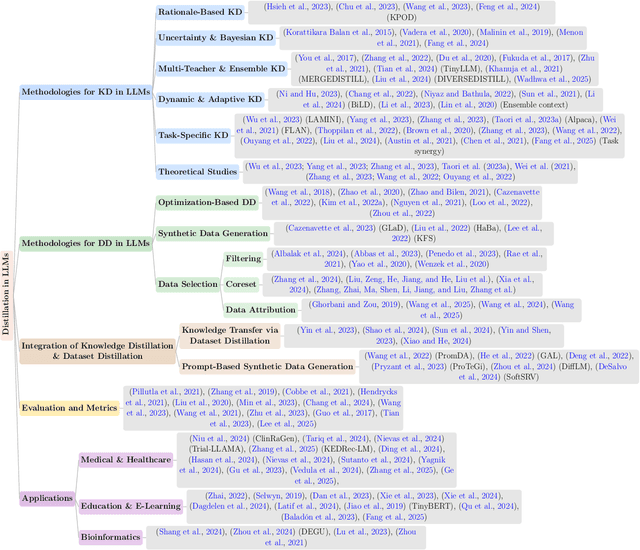
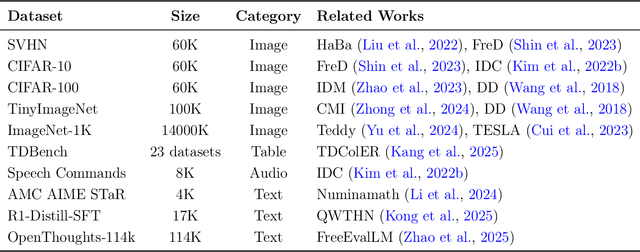
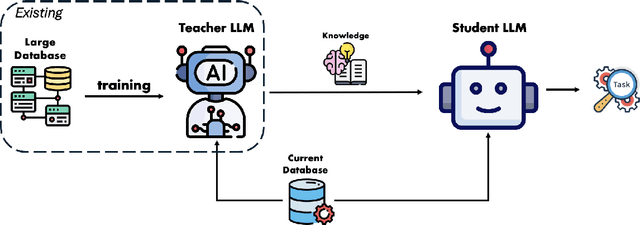
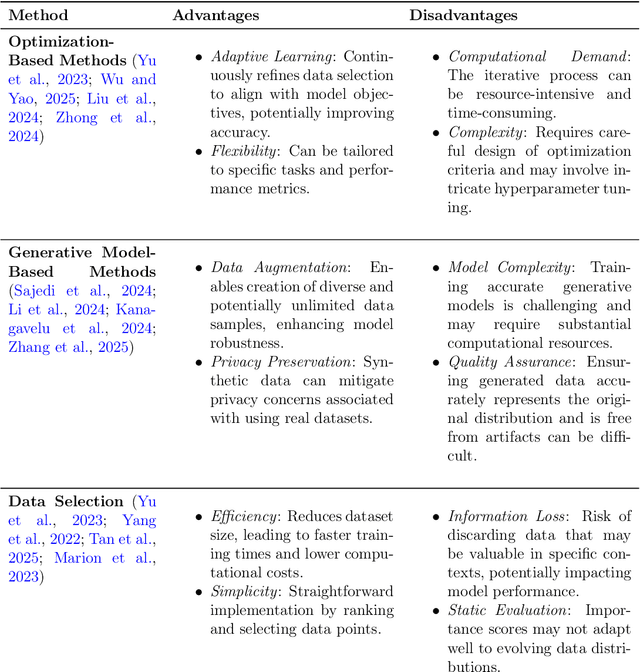
Abstract:The exponential growth of Large Language Models (LLMs) continues to highlight the need for efficient strategies to meet ever-expanding computational and data demands. This survey provides a comprehensive analysis of two complementary paradigms: Knowledge Distillation (KD) and Dataset Distillation (DD), both aimed at compressing LLMs while preserving their advanced reasoning capabilities and linguistic diversity. We first examine key methodologies in KD, such as task-specific alignment, rationale-based training, and multi-teacher frameworks, alongside DD techniques that synthesize compact, high-impact datasets through optimization-based gradient matching, latent space regularization, and generative synthesis. Building on these foundations, we explore how integrating KD and DD can produce more effective and scalable compression strategies. Together, these approaches address persistent challenges in model scalability, architectural heterogeneity, and the preservation of emergent LLM abilities. We further highlight applications across domains such as healthcare and education, where distillation enables efficient deployment without sacrificing performance. Despite substantial progress, open challenges remain in preserving emergent reasoning and linguistic diversity, enabling efficient adaptation to continually evolving teacher models and datasets, and establishing comprehensive evaluation protocols. By synthesizing methodological innovations, theoretical foundations, and practical insights, our survey charts a path toward sustainable, resource-efficient LLMs through the tighter integration of KD and DD principles.
Efficient Multi-Task Inferencing: Model Merging with Gromov-Wasserstein Feature Alignment
Mar 12, 2025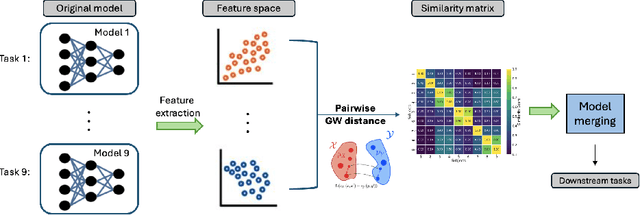
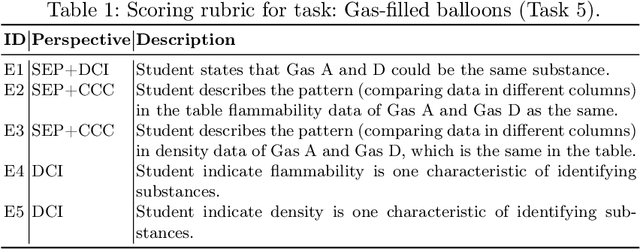
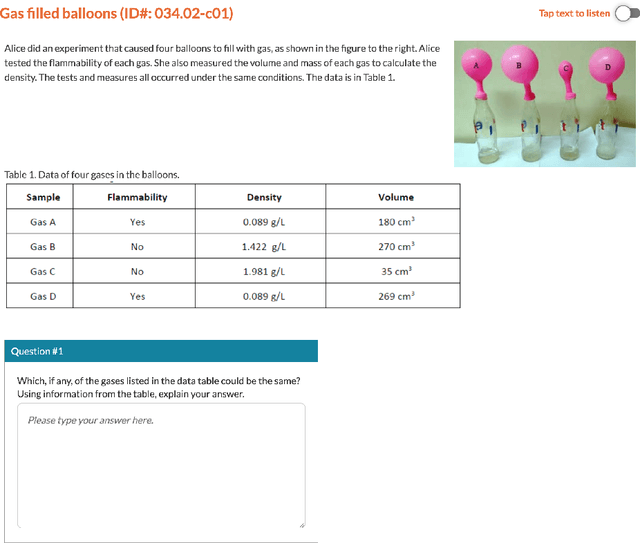

Abstract:Automatic scoring of student responses enhances efficiency in education, but deploying a separate neural network for each task increases storage demands, maintenance efforts, and redundant computations. To address these challenges, this paper introduces the Gromov-Wasserstein Scoring Model Merging (GW-SMM) method, which merges models based on feature distribution similarities measured via the Gromov-Wasserstein distance. Our approach begins by extracting features from student responses using individual models, capturing both item-specific context and unique learned representations. The Gromov-Wasserstein distance then quantifies the similarity between these feature distributions, identifying the most compatible models for merging. Models exhibiting the smallest pairwise distances, typically in pairs or trios, are merged by combining only the shared layers preceding the classification head. This strategy results in a unified feature extractor while preserving separate classification heads for item-specific scoring. We validated our approach against human expert knowledge and a GPT-o1-based merging method. GW-SMM consistently outperformed both, achieving a higher micro F1 score, macro F1 score, exact match accuracy, and per-label accuracy. The improvements in micro F1 and per-label accuracy were statistically significant compared to GPT-o1-based merging (p=0.04, p=0.01). Additionally, GW-SMM reduced storage requirements by half without compromising much accuracy, demonstrating its computational efficiency alongside reliable scoring performance.
Interpreting and Steering LLMs with Mutual Information-based Explanations on Sparse Autoencoders
Feb 21, 2025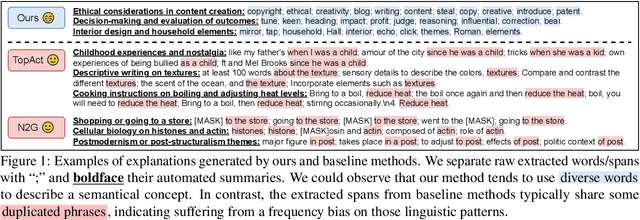
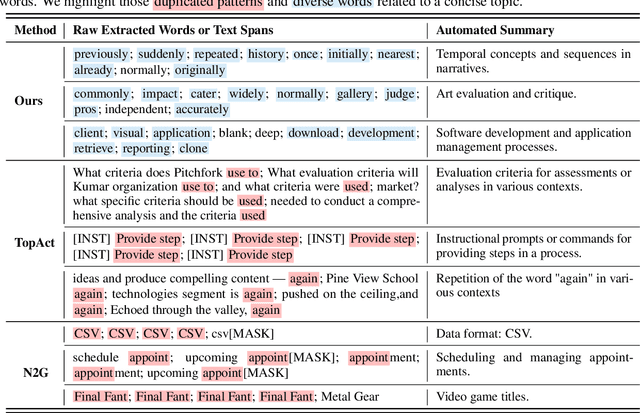
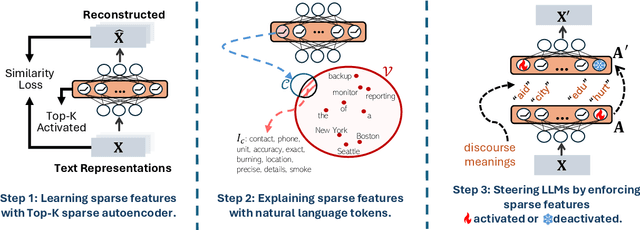
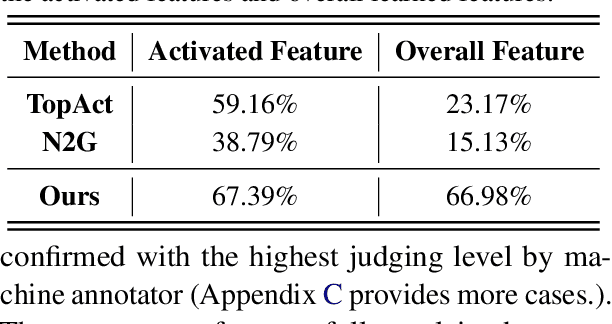
Abstract:Large language models (LLMs) excel at handling human queries, but they can occasionally generate flawed or unexpected responses. Understanding their internal states is crucial for understanding their successes, diagnosing their failures, and refining their capabilities. Although sparse autoencoders (SAEs) have shown promise for interpreting LLM internal representations, limited research has explored how to better explain SAE features, i.e., understanding the semantic meaning of features learned by SAE. Our theoretical analysis reveals that existing explanation methods suffer from the frequency bias issue, where they emphasize linguistic patterns over semantic concepts, while the latter is more critical to steer LLM behaviors. To address this, we propose using a fixed vocabulary set for feature interpretations and designing a mutual information-based objective, aiming to better capture the semantic meaning behind these features. We further propose two runtime steering strategies that adjust the learned feature activations based on their corresponding explanations. Empirical results show that, compared to baselines, our method provides more discourse-level explanations and effectively steers LLM behaviors to defend against jailbreak attacks. These findings highlight the value of explanations for steering LLM behaviors in downstream applications. We will release our code and data once accepted.
Self-Regularization with Latent Space Explanations for Controllable LLM-based Classification
Feb 19, 2025Abstract:Modern text classification methods heavily rely on contextual embeddings from large language models (LLMs). Compared to human-engineered features, these embeddings provide automatic and effective representations for classification model training. However, they also introduce a challenge: we lose the ability to manually remove unintended features, such as sensitive or task-irrelevant features, to guarantee regulatory compliance or improve the generalizability of classification models. This limitation arises because LLM embeddings are opaque and difficult to interpret. In this paper, we propose a novel framework to identify and regularize unintended features in the LLM latent space. Specifically, we first pre-train a sparse autoencoder (SAE) to extract interpretable features from LLM latent spaces. To ensure the SAE can capture task-specific features, we further fine-tune it on task-specific datasets. In training the classification model, we propose a simple and effective regularizer, by minimizing the similarity between the classifier weights and the identified unintended feature, to remove the impacts of these unintended features toward classification. We evaluate the proposed framework on three real-world tasks, including toxic chat detection, reward modeling, and disease diagnosis. Results show that the proposed framework can significantly improve the classifier's generalizability by regularizing those features that are not semantically correlated to each task. This work pioneers controllable text classification on LLM latent spaces by leveraging interpreted features to address generalizability, fairness, and privacy challenges. We will release our code and data once accepted.
Fine-tuning ChatGPT for Automatic Scoring of Written Scientific Explanations in Chinese
Jan 12, 2025



Abstract:The development of explanations for scientific phenomena is essential in science assessment, but scoring student-written explanations remains challenging and resource-intensive. Large language models (LLMs) have shown promise in addressing this issue, particularly in alphabetic languages like English. However, their applicability to logographic languages is less explored. This study investigates the potential of fine-tuning ChatGPT, a leading LLM, to automatically score scientific explanations written in Chinese. Student responses to seven scientific explanation tasks were collected and automatically scored, with scoring accuracy examined in relation to reasoning complexity using the Kendall correlation. A qualitative analysis explored how linguistic features influenced scoring accuracy. The results show that domain-specific adaptation enables ChatGPT to score Chinese scientific explanations with accuracy. However, scoring accuracy correlates with reasoning complexity: a negative correlation for lower-level responses and a positive one for higher-level responses. The model overrates complex reasoning in low-level responses with intricate sentence structures and underrates high-level responses using concise causal reasoning. These correlations stem from linguistic features--simplicity and clarity enhance accuracy for lower-level responses, while comprehensiveness improves accuracy for higher-level ones. Simpler, shorter responses tend to score more accurately at lower levels, whereas longer, information-rich responses yield better accuracy at higher levels. These findings demonstrate the effectiveness of LLMs in automatic scoring within a Chinese context and emphasize the importance of linguistic features and reasoning complexity in fine-tuning scoring models for educational assessments.
 Add to Chrome
Add to Chrome Add to Firefox
Add to Firefox Add to Edge
Add to Edge